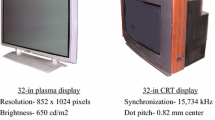Abstract
In Electric Sports (eSports) filed, High frequency displays such as 144 Hz and 240 Hz are more often used than 60 Hz display. In addition, it is said that people who use a high performance computer with graphics board are ahead of the eSports. Therefore, we have been studying the relationship between the performance of computers and reaction time of eSports. As a preliminary test, we conducted a simple reaction time test in which a button was clicked when the screen color changed. As the result, differences between 60 Hz, 120 Hz and 240 Hz cannot be ignored. It is assumed that the reaction time of each individual is constant, so this difference may be due to refresh-rate. This is because, the time of presenting light stimulus is different between each refresh-rate. Therefore, it has been suggested that using a display with high refresh-rate when competing in such as a simple game is advantageous.
Access this chapter
Tax calculation will be finalised at checkout
Purchases are for personal use only
Similar content being viewed by others
References
Chikish, Y., Carreras, M., Garci, J.: eSports: a new era for the sports industry and a new impulse for the research in sports (and) economics? In: Sports (and) Economics, pp. 477–508. FUNCAS (Spanish Savings Banks Foundation) (2019)
Happonen, A., Minashkina, D.: Professionalism in esport: benefits in skills and health & possible downsides. LUT Scientific and Expertise Publications (2019). ISBN 978-952-335-375-6
Griffiths, M.D.: The psychosocial impact of professional gambling, professional video gaming, and eSports. Casino Gaming Int. 28, 59–63 (2017)
Choi, C., Hums, M., Bum, C.H.: Impact of the family environment on juvenile mental health: esports online game addiction and delinquency. Int. J. Environ. Res. Public Health 15(12), 2850 (2018). https://doi.org/10.3390/ijerph15122850
Pedraza-Ramirez, I., Musculus, L., Raab, M., Laborde, S.: Setting the scientific stage for esports psychology: a systematic review. Int. Rev. Sport Exerc. Psychol. 13, 319–352 (2020). https://doi.org/10.1080/1750984X.2020.1723122
GeForce Powered High FPS CS:GO SLO-MO Video. https://www.youtube.com/watch?v=uJxxCgKa0mU
Does High FPS Make You a Better Gamer? – Favorite Moments. https://www.youtube.com/watch?v=x-kwlaKKhp4
Difference of hitting rate and scores between each refresh-rate of display 60hz, 144hz and 240hz [First half] “translated from Japanese”. https://www.youtube.com/watch?v=-UMnJHeyibk
Difference of hitting rate and scores between each refresh-rate of display 60hz, 144hz and 240hz [Second half] “translated from Japanese”. https://www.youtube.com/watch?v=HfiAOrdSKf0
Kosinski, R.J.: A Literature Review on Reaction Time. Clemson University, September 2013. https://www.cognaction.org/cogs105/readings/clemson.rt.pdf
Oyama, T.: Historical background and the present status of reaction time studies. Jpn. J. Ergon. 21(2), 57–64 (1985) ((in Japanese))
Unity, Unity Documentation, Retrieved from Unity (2020). https://docs.unity3d.com/ScriptReference/Application-targetFrameRate.html
Acknowledgments
This research was supported by a Grant from The Telecommunication Advanced Foundation.
Author information
Authors and Affiliations
Corresponding author
Editor information
Editors and Affiliations
Rights and permissions
Copyright information
© 2021 The Editor(s) (if applicable) and The Author(s), under exclusive license to Springer Nature Switzerland AG
About this paper
Cite this paper
Murakami, K., Miyashita, K., Miyachi, H. (2021). A Study on the Relationship Between Refresh-Rate of Display and Reaction Time of eSports. In: Barolli, L., Takizawa, M., Yoshihisa, T., Amato, F., Ikeda, M. (eds) Advances on P2P, Parallel, Grid, Cloud and Internet Computing. 3PGCIC 2020. Lecture Notes in Networks and Systems, vol 158. Springer, Cham. https://doi.org/10.1007/978-3-030-61105-7_34
Download citation
DOI: https://doi.org/10.1007/978-3-030-61105-7_34
Published:
Publisher Name: Springer, Cham
Print ISBN: 978-3-030-61104-0
Online ISBN: 978-3-030-61105-7
eBook Packages: EngineeringEngineering (R0)




